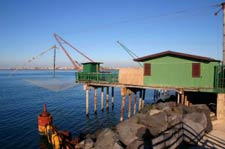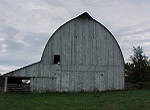Rural Economic Development Includes Diversifying
Last Updated: September 4, 2023
Rural economic development depends on taking an analytical look at which components of the historic farming, logging, mining, or tourism economic base are still viable. Strengthen those while exploring other options.
You can take advantage of the current urge to get out of cities to diversify your economy. "Work at home" has become a huge trend during the coronavirus pandemic, and we describe the implications for your economy below.
You need to figure out which businesses can be supported by your labor force, regional and international markets, and better utilization of existing strengths. Your geography and natural resources may lend themselves to developing new products or types of business, but many communities miss out on these opportunities because they are a little stuck mentally in trying to re-create their past glory.
Just like all local economies, rural economies have to take responsibility for themselves, promote creative new businesses that can sell to customers from outside the community, and diversify to reduce risk from too much concentration in one particular product or service.
The era of a truly global economy makes everything much less predictable, and your communities have to be ready for macro economic trends over which they have no control.
Most farm families in the United States have already taken action to increase their income and its predictability through the employment of at least one family member off the farm. That's a rational individual household action.
From the community development perspective, though, those jobs should be as close to the rural housing as possible, simply because reducing the commute to work makes sense in all cases.
That is where diversifying through rural economic development, and strengthening the non-agricultural elements of the local economy, becomes important.

In sum, a rural economic development program should be three-pronged:
- Increasing the soundness of the agricultural base through promoting best practices in farming, appropriate lending, assistance in adapting to new crops and livestock, and promoting new local market outlets.
- Attracting good-paying non-agricultural jobs to the community to provide diversification and additional income opportunities.
- Enhancing the interaction between agricultural and non-agricultural elements of the economic base so that new opportunities are discovered.
Increasing the Soundness of the Economic Base
As someone who grew up on a family farm, it's hard for me to hear the arguments that the family farm is obsolete, and that we should allow "big agriculture" to come in and rationalize agriculture just as many other industries have become efficient through economies of scale. But it's an argument I've considered very carefully, wanting to know the truth.
In the end, I don't think family farms deserve large government subsidies or protection from foreign competition. However, those who remain farmers should become much more agile and open-minded about which crops, practices, and products the market will support.
People in the developed countries are paying dearly for exotic vegetables, herbs, cheeses, wines, and fine cuisine, and I think a sound agriculture base would include:
- Catering to middle class and upper class tastes in food and drink around the world, of course combined with sound marketing to local restaurants, schools, and hospitals,
- Rapidly adapting crops to regain our edge as "bread basket to the world" as innovative high-protein, low-cost plants are bred to feed the truly hungry of the world, and
- Seizing opportunities for collecting and creating biomass that can be effectively turned into fuel (switchgrass, not corn), electricity that can be effectively fed back into the power grid (wind and solar, for instance), and adapting less energy-intensive ways to grow and harvest crops. Energy generation is already a major rural economic development opportunity in some places, but even more opportunity awaits.
This means that the unsubsidized farmer will have to compromise the lifestyle and products of the last couple of generations considerably, to become adept at changing direction and adopting a global perspective. To some degree many types of farmers have been skilled in this area for a long time. For example, they may have changed from one row crop to another row crop seamlessly as the markets for those products fluctuated. So we are not asking for totally new behavior; we are just asking that farmers become willing to change their products more frequently.
Figuring out what they want lettuce we want to eat in our chic restaurants can be a shared enterprise, though, requiring plenty of technical assistance and farmer-to-farmer communication.
Claiming the Economic and Social Benefits of Agriculture
I do think we should both (a) account for the environmental and social benefits of resident farming that aren't necessarily shown in the financial bottom line, and (b) account for the environmental and social costs of the large corporate farms.
Locally owned and managed farms provide the environmental benefits of open acreage that filter stormwater runoff and recharge groundwater aquifers.
They furnish certain types of wildlife habitat, especially if the row ends are left in native vegetation, as state and federal conservation programs encourage. The corporate farms tend to be pretty much of an environmental disaster, raising livestock on impervious concrete floors and collecting excrement in giant vats somewhat prone to failure.
In terms of social benefits, the locally owned family farms are clearly superior. If close enough to a city, they can sell high-quality, just-picked food locally, if the local community will support it.
When the process is formal, it is called community-supported agriculture (CSA) or subscription farming. Advance annual subscriptions are sold to non-farm families, who agree to accept the weekly baskets of vegetables, fruits, flowers, or herbs as they grow, without being fussy about whether it's sugar snap peas, basil, or sweet potatoes this week.
It's estimated that there are more than 2,000 subscription farms in the U.S. today. Considering that the first known arrangement occurred in Massachusetts in 1985, that's a rapidly spreading idea.
Part of the appeal must be the local connectedness, family to family, with the concept that non-farm households gain the small adventure of creatively preparing and enjoying fresh foods they haven't necessarily ordered.
There are many variations; sometimes the subscribers are called shareholders, and occasionally there is a requirement that the non-farm household provide some labor on the farm.
This locally supported agriculture deserves more consideration.
Other countries supply an increasing share of our food, and their safety
standards may not be the same as ours. And the transportation cost,
both financial and environmental, is enormous as a percentage of the
total cost. I'm not sure this is a total answer to rural economic development, but it's worth a look. The U.S. Department of Agriculture has compiled quite a handy and detailed resource page for CSAs.
Another idea gaining in popularity even in quite small towns is the farmer's market. Certainly there's an art to them, and many don't seem worth the farmer's time to spend a Saturday morning displaying crops and products.
It's rare to see supply and demand match exactly. But it's another way of deepening the social connection between farmer and consumer.
And agricultural uses may serve as part of the buffering against suburban sprawl at the edges of metropolitan areas. We choose the word "may" deliberately, because too often it seems that the conversion from native vegetation to agriculture is more of a precursor to development than to conservation.
But in rural areas where almost all land has been in agricultural use for a century or more, agriculture can be part of the imaginary line that planners need to draw to hold excess development, or sprawl, in check.
However, when farmers can sell their land for urban development, typically that means much higher property values, so they are going to sell unless there's a strong pull to stay on the land with sustainable agriculture.
Diversification for Rural Economic Development
Beyond stabilizing farm family income in order to preserve the best farms and the social benefits they confer, rural economic development is the same as economic development in any other location.
The exception is that some types of industries, and very large businesses in general, typically cannot survive in a rural location because of their economic inter-dependencies with other businesses.
However, we want to add that if your community can somehow be connected to high-quality broadband, your residents will be able to take advantage of the huge "work from anywhere" trend that has only been accelerated by the COVID-19 epidemic of 2020-2021. Work with your state government to identify what might be possible in terms of expanding your access to high-speed internet.
It's too early to tell if this urge to move to a more rural area will become an ongoing trend or if this is a momentary impulse that will disappear when the pandemic loses steam. However, the impact of improving your broadband will be permanent, and if you want to attract new residents who like a slower pace of life, easier access to nature, and a safe and friendly environment, begin to work steadily on the housing, amenities, and cultural life that former city dwellers will want and expect as they relocate from more frenetic areas.
Be forewarned that these changes can be jarring for your long-time residents, so careful community conversations are needed before you start putting out social media messages inviting city dwellers to come locate in your town in a "work from anywhere" culture. But with thoughtful deliberation beforehand, building population, talent, and economic resources through attracting remote workers can be a great strategy.
You might want to develop a co-working space so that these workers would have a somewhat office-like environment for those occasions when they want or need it. In fact, this could be a great use for a vacant building in your downtown area. You will need a presentable conference room and some comfortable seating areas that provide all the connectivity options that remote workers need. Barring the option or financing for a co-working space, maybe you can work with or start a local coffee shop to accomplish some of the same "third space" goals.
In fact, for all aspects of rural economic development, work closely with your state economic development department to (a) let them know you're serious about wanting to diversify your economy or even grow your population, (b) rely on the state's resources to give you sales leads you couldn't possibly afford to generate for yourselves, and (c) obtain the benefit of their wisdom and experiences about what types of businesses are realistic rural economic development possibilities.
To the extent that your state is relying on evidence, rather than naive hope, this will be helpful.
In many states the university extension service will be both a ready source of information and a provider of free technical assistance.
But in the end you have to take responsibility for growing your own jobs. True, towns of 200 and counties of 15,000 people can't necessarily do this on their own. It's worth thinking about combining forces into a group of counties that are similar or complementary in what they have to offer to entrepreneurs or employers. Where regional planning agencies or other consortia exist, take full advantage of their capabilities for convening groups of people and even facilitating their deliberations.
Forming various collaborations for economic development purposes is occurring at a rapid pace, both in rural and urban settings. Just don't use organizing a group as a substitute for facing stubborn issues that you already know about.
Otherwise, please study the remainder of the economic development portion of the site. Especially relevant might be the pages about entrepreneurship, since agriculture is a serious form of entrepreneurship and therefore kids who grew up on the farm often have an innate understanding of its rewards and demands.
Also check into the retail attraction page to understand the "I will if you will" program and how it might provide you with the several businesses each community needs to survive as a viable place to live.
Even though that page is written with a competition between suburbs in mind, your rural economic development program similarly would benefit from a couple of new businesses at the same time.
Many very small towns now have local history museums, often in the old railroad depot, closed school, or empty grain elevator. To give your museum a permanent boost, consider the Museum on Main Street program of the Smithsonian Institution.
The Smithsonian will provide and transport the exhibition to your local rural museum, and your town gets to have fun promoting and celebrating the event. In the process, the museum's board learns about marketing, handling volunteers, fundraising, planning special events, and how a good exhibit is prepared.
If you know or suspect that your housing wouldn't accommodate a successful rural economic development program, begin now to think about and plan for adding desirable rural housing.
You shouldn't build speculative housing, but at least having a plan for various housing types might be the difference between being able to attract a new employer and having them move on down the road.
There's No Need to Give Up on Agriculture
So because there are social and environmental benefits that are unique to agriculture, rural communities should investigate and support fully a positive future for agriculture as practiced in their climate, soil conditions, and cultural environment.
Engage your state university's extension service, if you have one, in helping you as a community evaluate realistically what opportunities for raising crops and livestock are economically viable, environmentally sustainable, and least subject to climate changes and natural disasters. Then start a realistic discussion about whether agriculture provides enough income for your community, and if not, what role it can play in supporting households.
Sometimes you can organize a task force that represents the entire community to debate the role of agriculture. This is rural economic development at its finest.
A Pleasing Quality of Life in Agricultural Areas
Just like a larger town, you will be successful in rural economic development only when you make sure that the quality of life that you offer is attractive. If you don’t have a movie theater, so what?
In some ways, the electronic age makes it easier now than ever to provide what households need and crave in a rural environment. Most people want a sense of community, and a rural background is great training in that.
One useful concept is finding new residents who are eager to be exposed to nature and slow the pace of their lives. This might include some work-at-home younger folks. There is also positive potential in drawing in retirees who now live elsewhere. For more on this topic, see our answer to a question that one of our visitors asked about promoting their community as a retirement location.
But rural places have personalities too, and if your personality shows that people are lazy, too fiercely independent to work together, and too insensitive to community need to confront eyesores and obvious problems, you'll have a hard time with economic diversification.
So take care of that excess cat population, paint up a few buildings, figure out why that broken windmill is still in the middle of Main Street, clean up some of the junk cars in front yards on the main road into town, and figure out how to have farmers say something nice about the townspeople, and vice versa, when your new prospect comes into town.
You don't have to look bigger or more sophisticated than you are, but you do need to look as though you care. Unless everyone really is dirt poor, don't give that appearance. It sends a bad message to people who are thinking of investing their money. You want them to think that rural economic development isn't a brand new idea to you.
But remember that entrepreneurship is the best step in rural economic development. And in rural areas some elements that lead to creative ideas, including accidental collision of unexpected ideas side by side, don't happen spontaneously too much. So part of your rural economic development program is having creativity sessions.
Yes, we are serious, but don't call them that! Just say that you're going to have a program once a month at the extension center, and it will introduce your local folks to rural people across the nation who have figured out unusual ways to make money.
By miracles of modern media, you can import video, slideshows, and even teleconferences that you wouldn't have dreamed of having access to fifty years ago. Have refreshments, but make everything about the event, from the name tags to the napkins to the food to the program, something a little different from the normal, and make these conversation pieces something made or manufactured in rural areas.
So expose yourselves to new ideas and projects from rural people, and with the honesty, integrity, and work ethic of most rural communities, you never know what could happen.
Make Your Rural Community as Attractive to Development As Possible
A rural community is unlikely to be successful in finding and nurturing new businesses and in providing new employment opportunities unless it is willing to tackle the basics of making a community attractive to today's families. So if you are serious about economic development, you need to dig into the topics below as they are applicable to your situation. Every one of them is critical to your success in bringing in more business.
If you hope to attract new residents, you will need to meet or exceed their expectations in terms of housing quality, orderliness, and charm.
Join GOOD COMMUNITY PLUS, which provides you monthly with short features or tips about timely topics for neighborhoods, towns and cities, community organizations, and rural or small town environments. Unsubscribe any time. Give it a try.




